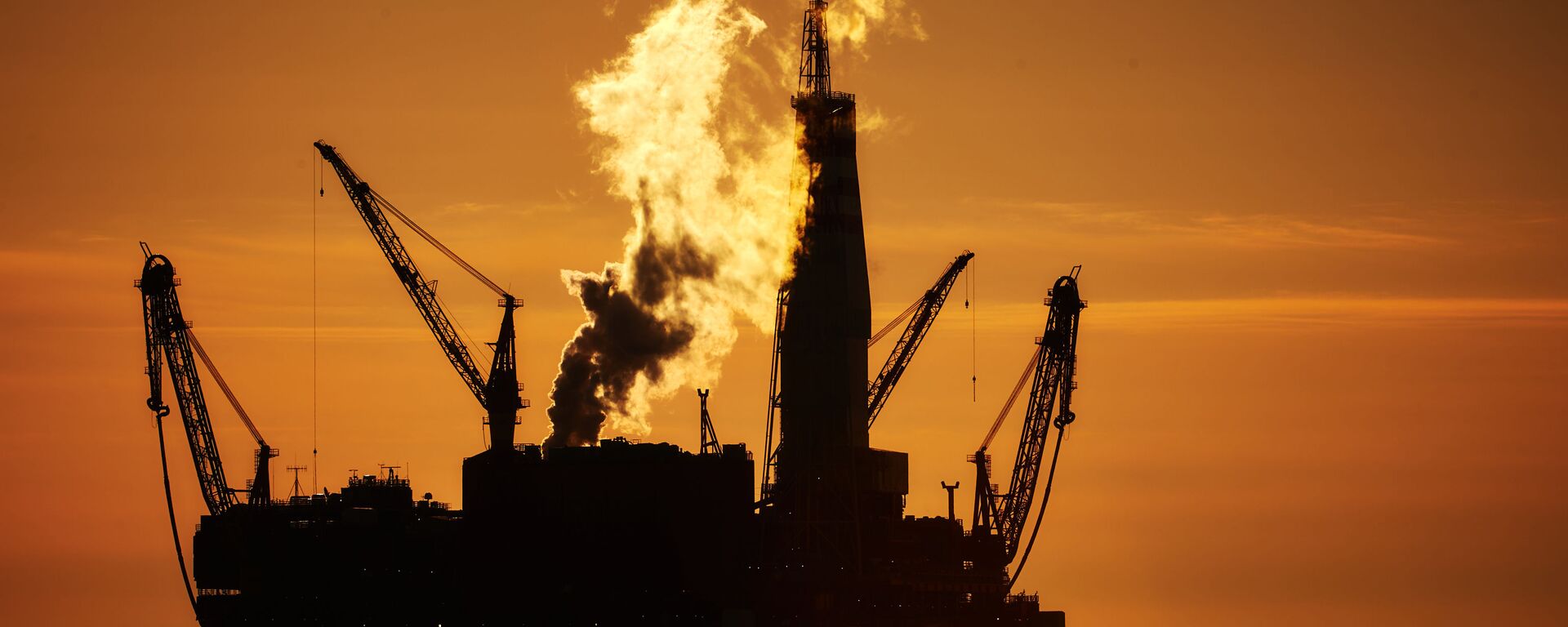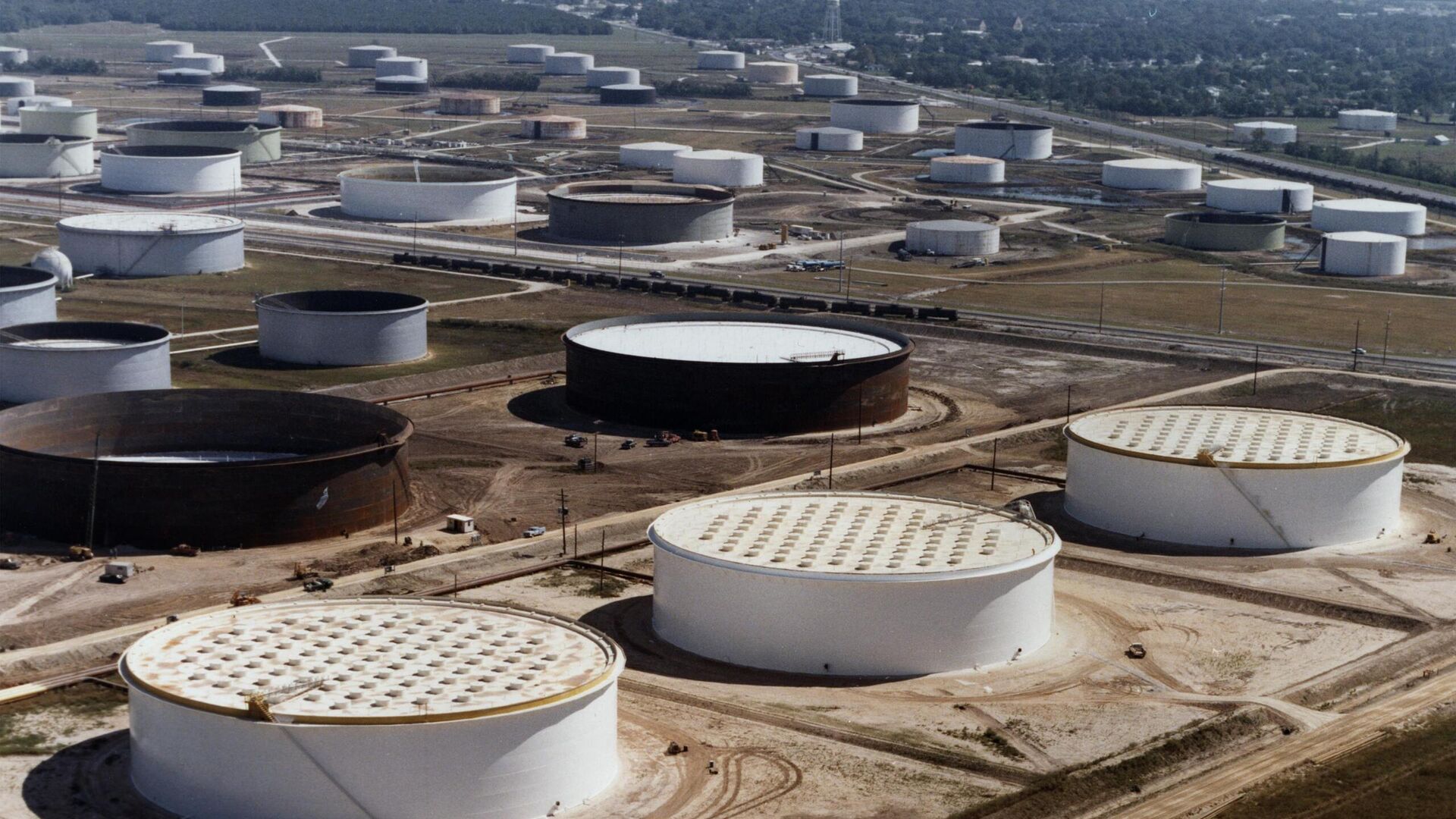https://sputnikglobe.com/20220924/us-oil-buffer-at-historic-low-in-wake-of-joe-bidens-unprecedented-spr-release-strategy-1101162021.html
US ‘Oil Buffer’ at Historic Low in Wake of Joe Biden’s ‘Unprecedented’ SPR Release Strategy
US ‘Oil Buffer’ at Historic Low in Wake of Joe Biden’s ‘Unprecedented’ SPR Release Strategy
Sputnik International
The US Energy Department said on September 19 that it would sell up to 10 million barrels of oil from the Strategic Petroleum Reserve, for delivery in... 24.09.2022, Sputnik International
2022-09-24T08:08+0000
2022-09-24T08:08+0000
2022-11-15T14:20+0000
americas
us
joe biden
crude
strategic petroleum reserve (spr)
oil
https://cdn1.img.sputnikglobe.com/img/07e6/03/1f/1094365039_0:0:2560:1441_1920x0_80_0_0_9934dd6454a7bc5ca60f04a72090eec6.jpg
The US has been drawing crude from its Strategic Petroleum Reserve (SPR) at such a rapid pace this year that it is running out of its oil buffer, The Wall Street Journal reported.The SPR declined by nearly seven million barrels in the week ending September 16, according to data from the US Energy Information Administration. This left the largest publicly known emergency supply of oil in the world with approximately 427 million barrels - the lowest level since 1984.Furthermore, for the first time since 1983, the emergency stockpile of petroleum maintained by the United States Department of Energy (DOE) holds less oil than commercial storage.The SPR’s underground tanks in Louisiana and Texas have capacity for 714 million barrels (113,500,000 m3).The Energy Department announced on September 19 that it had released an estimated 155 million barrels of crude since President Joe Biden on March 31, 2022 authorized the largest-ever sale of oil from the SPR to help lower energy costs for American families. The release of one million barrels a day over a span of six months was touted by the US president as a “wartime bridge to increase oil supply into production,” in remarks at the White House. Since the March announcement, this implies a draw of slightly less than 900,000 barrels a day.Also on Monday, the DOE’s Office of Petroleum Reserves announced a Notice of Sale of up to 10 million barrels of crude oil to be delivered from the SPR in November 2022, in an extension beyond the initial October target. Deliveries of oil low in sulfur, known as sweet crude, are to come from the Big Hill and West Hackberry SPR storage sites. This would leave only around 15 million barrels potentially available for sale under the emergency authorization.‘Politicized Use’ of CrudeWhen Joe Biden resorted to the emergency authorization, he sought to tame pump prices in the run-up to the November 8, 2022 midterm elections, in which the Democrats hope to keep control of Congress.Since June 2022, according to the DOE, retail gas prices have dropped for more than 13 consecutive weeks. Gasoline prices currently average $3.66 a gallon after reaching a shock high of $5.03 in mid-June, according to GasBuddy.However, the release from the SPR didn’t turn out to be necessary for "energy security," The Wall Street Journal underscored.The US, Britain, and the EU slapped seven packages of sanctions on Russia in response to Moscow launching its special military operation in Ukraine on February 24, 2022. Brussels pledged to end its dependence on Russian energy supplies, approving a gradual phase-out of Russian oil. The last package, adopted on July 21, provided for a complete import ban on all Russian seaborne crude oil as of December 5, 2022, and petroleum products as of February 5, 2023. The restrictions led to an energy crisis in the EU, Britain, and many other countries amid record-high fuel prices and skyrocketing inflation.The International Energy Agency (IEA) initially forecast that Russia’s oil production would be cut by three million barrels a day after it launched its special military operation in Ukraine. At the time, there was an argued “perceived supply emergency” due to the Ukraine crisis and the ensuing sanctions targeting Russia, Bob McNally, president of the energy-consulting firm Rapidan Energy Group, was cited as saying.However, as of August, Russia’s exports were down just 400,000 to 450,000 barrels daily since the Ukraine crisis escalated, according to the latest IEA report.“High prices are inconvenient. Lack of availability is a crisis,” warned Dan Pickering, chief investment officer at Pickering Energy Partners.Experts warn that depleted SPR levels are a risky option with continuing supply-demand volatility.Firstly, after December 5, the European Union’s import ban on Russian oil takes effect. IEA experts predict that Russia’s daily oil output could be 1.9 million barrels below levels registered before the Ukraine crisis by February 2023.Furthermore, the Group of Seven nations earlier confirmed their intention to impose price caps for Russian oil as part of expanded sanctions against the country.Russian Deputy Prime Minister Alexander Novak slammed the move as absurd, warning that Moscow would not deliver oil and oil products to countries that support the decision.On top of that, the Organization of the Petroleum Exporting Countries (OPEC) has signaled that it will slash output if prices plummet. Another potential hazard is looming recession, the report added, pointing out that depleted strategic oil reserves could leave the US with few options at its disposal.While Joe Biden could technically authorize more SPR drawdowns, the IEA has a minimum stockholding obligation for participating members. For the US, this number is approximately 315 million barrels, according to RBC Capital Markets.The DOE will eventually have to replenish the SPR by the same amount that it drew this year, in effect increasing future oil demand, the report emphasized. Such replenishment won’t likely occur until September 2023, a DOE spokesperson was cited as saying.Thus, the Biden administration’s SPR draw may have served only short-term political gain, if there is an actual oil shock coming, and the US will not have enough oil to cushion its effect, the report concluded.
https://sputnikglobe.com/20220708/republicans-slam-biden-for-allowing-spr-oil-to-be-shipped-overseas-1097088585.html
https://sputnikglobe.com/20220401/chickens-have-come-home-to-roost-why-bidens-spr-release-unlikely-to-curb-oil-prices-1094400491.html
https://sputnikglobe.com/20220909/us-hails-price-cap-on-russian-energy-but-europe-is-left-in-the-dark-1100557397.html
https://sputnikglobe.com/20220920/us-senators-seek-to-enforce-cap-on-russia-oil-prices-through-secondary-sanctions-report-says-1101012273.html
americas
Sputnik International
feedback@sputniknews.com
+74956456601
MIA „Rossiya Segodnya“
2022
News
en_EN
Sputnik International
feedback@sputniknews.com
+74956456601
MIA „Rossiya Segodnya“
Sputnik International
feedback@sputniknews.com
+74956456601
MIA „Rossiya Segodnya“
us, joe biden, crude, strategic petroleum reserve (spr), oil
us, joe biden, crude, strategic petroleum reserve (spr), oil
US ‘Oil Buffer’ at Historic Low in Wake of Joe Biden’s ‘Unprecedented’ SPR Release Strategy
08:08 GMT 24.09.2022 (Updated: 14:20 GMT 15.11.2022) The US Energy Department said on September 19 that it would sell up to 10 million barrels of oil from the Strategic Petroleum Reserve, for delivery in November. In March, Joe Biden announced that he was releasing one million barrels a day from the SPR for six months in an attempt to lower soaring fuel prices.
The US has been
drawing crude from its Strategic Petroleum Reserve (SPR) at such a rapid pace this year that it is running out of its oil buffer, The Wall Street Journal reported.
The SPR declined by nearly seven million barrels in the week ending September 16, according to data from the US Energy Information Administration. This left the largest publicly known emergency supply of oil in the world with approximately 427 million barrels - the lowest level since 1984.
Furthermore, for the first time since 1983, the emergency stockpile of petroleum maintained by the United States Department of Energy (DOE) holds less oil than commercial storage.
The SPR’s underground tanks in Louisiana and Texas have capacity for 714 million barrels (113,500,000 m3).
The Energy Department
announced on September 19 that it had released an estimated 155 million barrels of crude since President Joe Biden on March 31, 2022 authorized the largest-ever sale of oil from the SPR to help
lower energy costs for American families. The release of one million barrels a day over a span of six months was touted by the US president as a “wartime bridge to increase oil supply into production,” in remarks at the White House. Since the March announcement, this implies a draw of slightly less than 900,000 barrels a day.
Also on Monday, the DOE’s Office of Petroleum Reserves announced
a Notice of Sale of up to 10 million barrels of crude oil to be delivered from the SPR in November 2022, in an extension beyond the initial October target. Deliveries of oil low in sulfur, known as sweet crude, are to come from the Big Hill and West Hackberry SPR storage sites. This would leave only around 15 million barrels potentially available for sale under the emergency authorization.
‘Politicized Use’ of Crude
When Joe Biden resorted to the emergency authorization, he sought to tame pump prices in the run-up to the November 8, 2022
midterm elections, in which the Democrats hope to keep control of Congress.
Since June 2022, according to the DOE, retail gas prices have dropped for more than 13 consecutive weeks. Gasoline prices currently average $3.66 a gallon after reaching a shock high of $5.03 in mid-June, according to GasBuddy.
However, the release from the SPR didn’t turn out to be necessary for "energy security," The Wall Street Journal underscored.
The US, Britain, and the EU slapped seven packages of sanctions on Russia in response to Moscow launching its special military operation in Ukraine on February 24, 2022. Brussels pledged to end its dependence on Russian energy supplies, approving a gradual phase-out of Russian oil. The last package, adopted on July 21, provided for a complete import ban on all Russian seaborne crude oil as of December 5, 2022, and petroleum products as of February 5, 2023. The restrictions led to an energy crisis in the EU, Britain, and many other countries amid record-high fuel prices and skyrocketing inflation.
The International Energy Agency (IEA) initially forecast that Russia’s oil production would be cut by three million barrels a day after it launched its special military operation in Ukraine. At the time, there was an argued “perceived supply emergency” due to the Ukraine crisis and the ensuing
sanctions targeting Russia, Bob McNally, president of the energy-consulting firm Rapidan Energy Group, was cited as saying.
However, as of August, Russia’s exports were down just 400,000 to 450,000 barrels daily since the Ukraine crisis escalated, according to the latest IEA report.
“High prices are inconvenient. Lack of availability is a crisis,” warned Dan Pickering, chief investment officer at Pickering Energy Partners.
Experts warn that depleted SPR levels are a risky option with continuing supply-demand volatility.
Firstly, after December 5, the European Union’s import ban on Russian oil takes effect. IEA experts predict that Russia’s daily oil output could be 1.9 million barrels below levels registered before the Ukraine crisis by February 2023.
9 September 2022, 10:13 GMT
Furthermore, the Group of Seven nations earlier confirmed their intention to impose
price caps for Russian oil as part of expanded sanctions against the country.
Russian Deputy Prime Minister Alexander Novak slammed the move as absurd, warning that Moscow would not deliver oil and oil products to countries that support the decision.
On top of that, the Organization of the Petroleum Exporting Countries (OPEC) has signaled that it will slash output if
prices plummet. Another potential hazard is looming recession, the report added, pointing out that depleted strategic oil reserves could leave the US with few options at its disposal.
While Joe Biden could technically authorize more SPR drawdowns, the IEA has a minimum stockholding obligation for participating members. For the US, this number is approximately 315 million barrels, according to RBC Capital Markets.
The DOE will eventually have
to replenish the SPR by the same amount that it drew this year, in effect increasing future oil demand, the report emphasized. Such replenishment won’t likely occur until September 2023, a DOE spokesperson was cited as saying.
Thus, the Biden administration’s SPR draw may have served only short-term political gain, if there is an actual oil shock coming, and the US will not have enough oil to cushion its effect, the report concluded.

20 September 2022, 13:57 GMT





